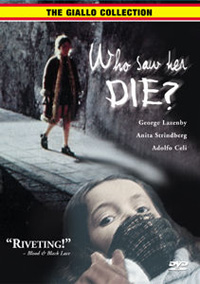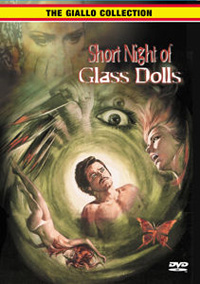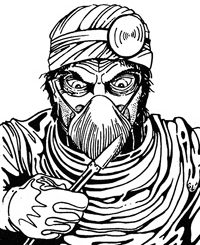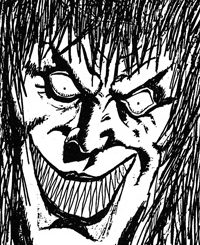 Coroner’s Corner
Coroner’s Corner
By John Bikowski
Anchor Bay Entertainment has once again proven that they are the leaders in European horror and exploitation by releasing The Giallo Collection. You may be thinking, “Sweet… I just gotta get me a collection of Giallo… What the hell is it?” Basically, the word Giallo means yellow, which was the dust jacket cover of a genre of lurid mystery novels that thrilled Europeans in the ’60s and ’70s. These stories were famous for their twists, quirky characters, suspense and more importantly, their controversial doses of sex and violence. Some of the more famous directors of cinematic Giallo include Dario (Deep Red) Argento, Lucio (New York Ripper) Fulci, and both Lamberto (A Blade in the Dark) and Mario (Bay of Blood) Bava. Anchor Bay has released several suspense films from some of the lesser-known (in America, anyhow) Italian directors.
The first film, Who Saw Her Die?, runs 94 minutes, is not rated, and was released in 1972. Also included on the DVD are the trailer, a director filmography, and Death in Venice, an all-new 11-minute interview with director Aldo Lado. The widescreen presentation looks and sounds infinitely better than the bootleg VHS I saw years ago. This release is actually pretty timely considering the recent media spotlight on abducted children.
The action begins with a little girl being grabbed by an unseen assailant and subsequently beaten to death with a rock. Over the violence and suspense, Ennio Morricone provides a haunting score that sounds like kids imitating geese… very creepy. We then learn that cute little redheaded Nicoletta Elmi, whose mother is the obligatory Euro-Hottie, is in Venice with her sculptor Dad. He loves his daughter very much, but he still leaves plenty of opportunity for her to be violated (like when he has an impromptu sexual romp). The psycho killer catches up to the young girl and does the deed. The father then spends the remainder of the film trying to find his daughter’s murderer. The closer he gets to the truth, the more murders are added to the tale. Will he die before he learns the truth? Check it out. Worth viewing mainly for the style, the music, and the patented quirky characters such as a guy who’ll only give information while you play him in ping-pong.
 Next we have Short Night of Glass Dolls, also directed by Lado, which goes down in the “What the Hell does that title mean?” hall of fame alongside Fulci’s Don’t Torture a Duckling. The film runs 97 minutes, is not rated, and was released in 1971. This DVD also features the trailer, filmography, and Strange Days of the Short Night, an interview with Lado about the film. While viewing this film, I became aware of many of the recurring aspects that set Giallo films up as their own niché in cinema. Short Night… contains them all: Mystery-enhancing European settings, gorgeous European ladies, unique musical scores (again provided by Ennio Morricone), and plenty of on-screen violence.
Next we have Short Night of Glass Dolls, also directed by Lado, which goes down in the “What the Hell does that title mean?” hall of fame alongside Fulci’s Don’t Torture a Duckling. The film runs 97 minutes, is not rated, and was released in 1971. This DVD also features the trailer, filmography, and Strange Days of the Short Night, an interview with Lado about the film. While viewing this film, I became aware of many of the recurring aspects that set Giallo films up as their own niché in cinema. Short Night… contains them all: Mystery-enhancing European settings, gorgeous European ladies, unique musical scores (again provided by Ennio Morricone), and plenty of on-screen violence.
The first scene unfolds with a pigeon discovering a corpse in a Prague plaza. This is no ordinary dead body, however. This one can still hear and see, but it cannot move. Think about that… That would really suck. This poor sap is a reporter named Greg Moore who was investigating the death of his gorgeous girlfriend (Barbara Bach). Apparently, he was closing in on some type of cult of killers and now he is chilling out in the holding tank of the morgue, silently begging for someone to realize his predicament. I had to laugh when the attendant slides him in the storage compartment under another corpse and Greg yells, “Hey, you there…” and is actually surprised to not get a response. Greg then flashes his memory back with the hope of remembering how he came to his death-like paralysis. Unfortunately, he is running low on time because he’s scheduled for an autopsy. But before that happens we’re introduced to a mystery involving naked dead girls and a descent into madness that ends in a crazy, nude, ritual orgy. Throw in a very strange autopsy finale, and there you have it.
 Rounding out Anchor Bay’s collection is my favorite of the three, The Bloodstained Shadow. This 1978 film is also unrated and runs 109 minutes. Included on the DVD are the trailer, a filmography and Solamente Bido, a 13-minute interview with the director Antonio Bido. Here we have another timely release, thanks to the media filling us in on the growing number of evil-doing priests in the Catholic Church. As for the music, instead of Morricone, the rocking score is provided by Goblin, who became famous providing the music for many of Argento’s masterworks.
Rounding out Anchor Bay’s collection is my favorite of the three, The Bloodstained Shadow. This 1978 film is also unrated and runs 109 minutes. Included on the DVD are the trailer, a filmography and Solamente Bido, a 13-minute interview with the director Antonio Bido. Here we have another timely release, thanks to the media filling us in on the growing number of evil-doing priests in the Catholic Church. As for the music, instead of Morricone, the rocking score is provided by Goblin, who became famous providing the music for many of Argento’s masterworks.
We begin with the up-close slow motion strangulation of a schoolgirl. This early murder was committed many years back and ties in as an important clue during the resolution. A young college professor named Stefano returns to an island near Venice to visit his brother Paulo, who happens to be a Catholic Priest. Paulo introduces us to a strange collection of community members, such as a fraudulent medium who is quickly murdered. Soon more people turn up dead with taunting notes sent to Paulo. Meanwhile, Stefano hooks up with the attractive but strange Stefania (Suspiria) Casini and they begin to investigate on their own. Despite the growing danger, they thankfully take time to engage in a very revealing sex scene. This film held my interest through moody cinematography, sympathetic characters, and its own unique mean streak. For example, one crippled old woman is dumped into a raging fireplace. Not exactly what you would call politically correct death. If you enjoyed classics like Deep Red and Bird With the Crystal Plumage, you’ll also like The Bloodstained Shadow.
(www.anchorbayentertainment.com)



